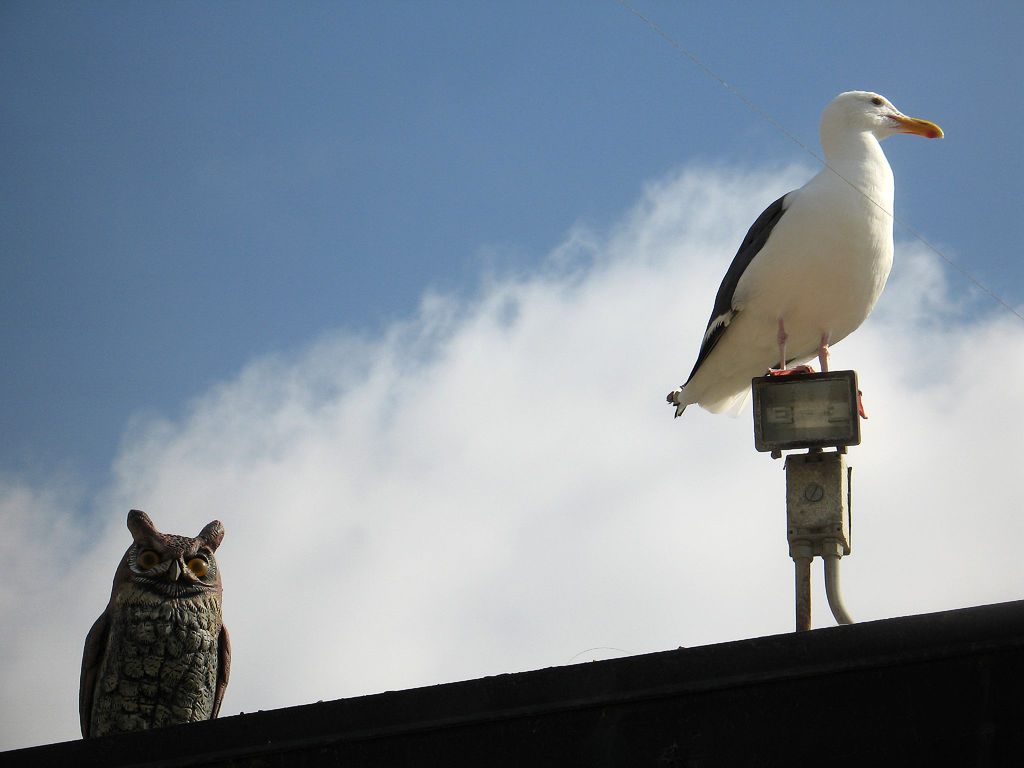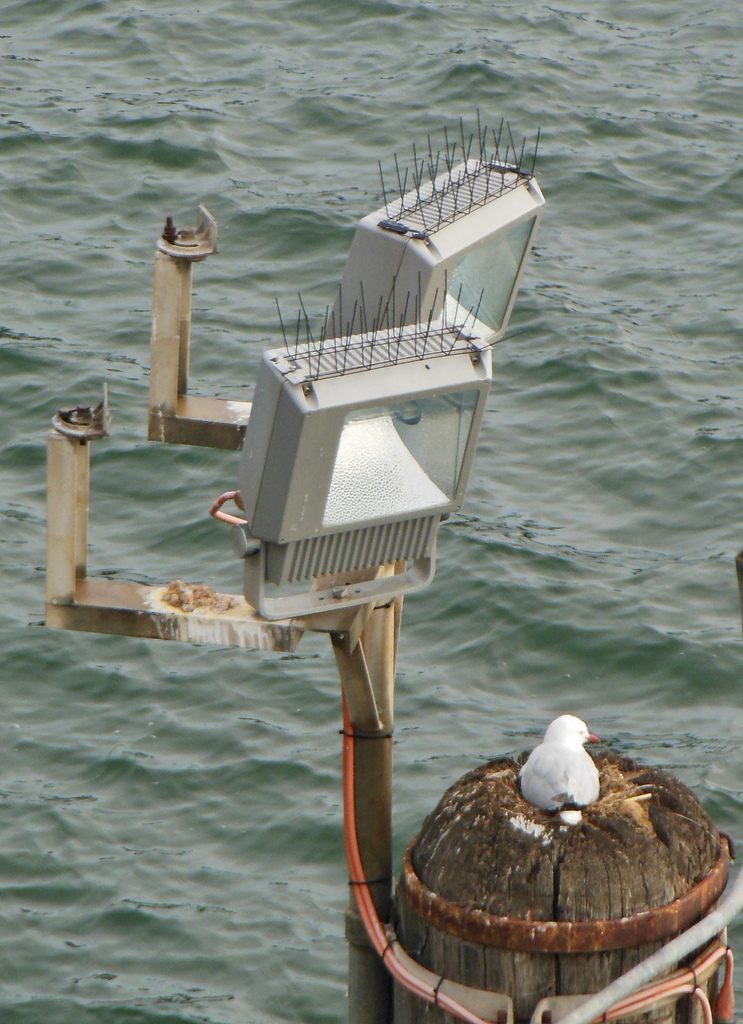Humans Are Losing The One-Sided War Against Seagulls
Our many technological failures inspire the question—should we even fight?

A seagull, unimpressed with human ingenuity. (Photo: John D./CC BY 2.0)
Late last month, swimmers and boaters who made their way around the far end of Mt. Baker Terminal Pier in Mukilteo, Washington were rewarded by a gruesome sight. Suspended from the pier’s edge swung a whole passel of dead seagulls, wings and legs akimbo, like victims of an Old West hanging spree.
Backlash was immediate. Local kayakers got scared. Bird enthusiasts statewide got vengeful. And the USDA, who strung up the birds in the first place, got defensive, telling Komo News that the tactic is “a common practice,” and has been used for years to warn away other gulls, whose droppings leave the pier dangerously slippery.
This American-style tactic against seagulls is worse than bloody, it’s ineffective. But when it comes to questionable gull-human relations, Americans have nothing on the Brits. In the UK and Ireland, gulls have made even more dramatic inroads in urban areas, finding them to be perfect nesting zones. It is difficult to overstate how many different tactics—fake animals, hostile architecture, complex egg-replacement schemes—we’ve come up with to get rid of them. If human experiences have taught us anything, one British expert says, it’s that if you try and scare off seagulls, you usually only end up playing yourself.
Seagulls hanging from the Washington pier. (Photo: Facebook)
The UK’s seagull invasion began 60 years ago, when Parliament passed the Clean Air Act of 1956. Meant to reduce smog and shift households towards cleaner energy, the legislation barred landfill owners from burning their trash onsite, essentially turning the dumps into a gull buffet. Drawn by the free food, the seagulls hung around, thrived, and spread into the cities, where they found they liked the tall buildings—real estate’s answer to seaside cliffs—and the predator-free lifestyle.
“We basically gave these birds an invitation,” says Pete Rock of Bristol University, who has been studying urban gulls for nearly 40 years. Since the last official survey in 2000, Rock says, the number of colonies has more than doubled. The rooftops of Britain and Ireland may now host as many as 100,000 breeding pairs.
Gulls are, in many ways, bad neighbors. They greet the dawn loudly and with great enthusiasm, even when it comes at 4 a.m.. (Thanks to 24-hour street lighting, they tend to get psyched about nighttime, too.) They poop with abandon, eat out of the trash, and tear up rooftops over small territorial slights. Brand new research, also out of England, shows that they’ve learned when all the pubs close, so as to better snatch food from drunken revelers. Occasionally, if they think their nests are in danger, they’ll take a swoop at someone.

A European herring gull goes after a man’s lunch. (Photo: loki11/Public Domain)
Living alongside 200,000 avian frat boys takes its toll. “Most people hate them with some kind of vengeance,” says Rock, who has done gull-related public opinion surveys in his own community of Bristol. “One woman had to ask people who were telephoning her to call at a quieter time. Another’s boyfriend wouldn’t visit her during gull breeding season.” Some senior citizens have taken to carrying protective umbrellas, to save themselves from what they describe as “pterodactyl-style” dive-and-poops. Last week, a gull contingent in Cumbria prevented the mail from going through.
Mobilized by this threat to the citizenry, authorities have been inspired to action—action that often takes somewhat ridiculous forms. First, Rock says, came the plastic owls, imperious-looking decoys that can be found surveying roofs and beaches around Britain. Terrifying as they are, though, these owls do not actually scare seagulls. “They don’t sound like anything, they don’t smell like anything,” says Rock. “I have a picture of a herring gull asleep at the feet of one.”

An Australian gull gets around some spikes. (Photo: Michael Coghlan/CC BY-SA 2.0)
Next came piped-in distress calls, meant to mimic birds telling each other to stay away. “When you first play it, all the gulls get up in the air because they wonder what’s going on,” says Rock. “It only takes a day or two before they suss out that this is no threat whatsoever.” They settle back in quickly, and after a few days, when they hear it, “they just turn their heads.” (Plus, even if the birds do scram for a bit, the fake calls themselves annoy people—residents of Aberdeen City recently petitioned to have a squawky speaker, which blared from nine to five every weekday, switched off.)
It’s the same story with pretty much every scare tactic—falcon-shaped drones, spiked lampposts, colored flags, holographic French Fry packages. “There are all sorts of weird and wonderful bits of equipment,” says Rock. But if you do manage to annoy a few seagulls away from your home or place of business, they’ll simply move next door. And if they’ve already chosen their nesting site, forget it. “I’ve seen birds incubating as the building they’re nesting on is demolished around them,” says Rock.
More intensive strategies—like in Dunfries, Scotland, where authorities have culled 20,000 eggs this year—may chip away at the seagull population, but they still leave humans far behind on the numbers game. Gulls can live up to 35 years, say Rock: “If they miss a few seasons of breeding, so what?” And birds who notice that their eggs are going missing are smart enough to move, too. “You can displace birds from your roof,” says Rock, “But that doesn’t stop them from breeding on next year’s roof.”

Some street tough gulls in Brooklyn—look out, U.S. (Photo: Julie Feinstein/CC BY 2.0)
Rock doesn’t have a seagull silver bullet. If we want to cut down on gulls, he says, we need to start thinking of them as a symptom of our own decisions, rather than a problem that has swooped down out of nowhere. “The gulls are holding up a mirror to society,” he says. “We have to confront ourselves if we are to do something about this”—cut down on trash, look at how we’re treating our beaches, get to know our avian neighbors, and stop trying to send all our problems squawking into the next guy’s yard.
Speaking of the next guy, America may want to take notes. “You have gulls beginning to breed on rooftops creeping down the Eastern seaboard,” Rock says. Our own fry-stealing, dawn-greeting beach scourges may be coming to our cities sooner than we think.
In the meantime, we had better come up with something better than hangings. “I have a picture of a nest on top of a dead seagull,” says Rock. Back to the drawing board.
Naturecultures is a weekly column that explores the changing relationships between humanity and wilder things. Have something you want covered (or uncovered)? Send tips to cara@atlasobscura.com.

















Follow us on Twitter to get the latest on the world's hidden wonders.
Like us on Facebook to get the latest on the world's hidden wonders.
Follow us on Twitter Like us on Facebook